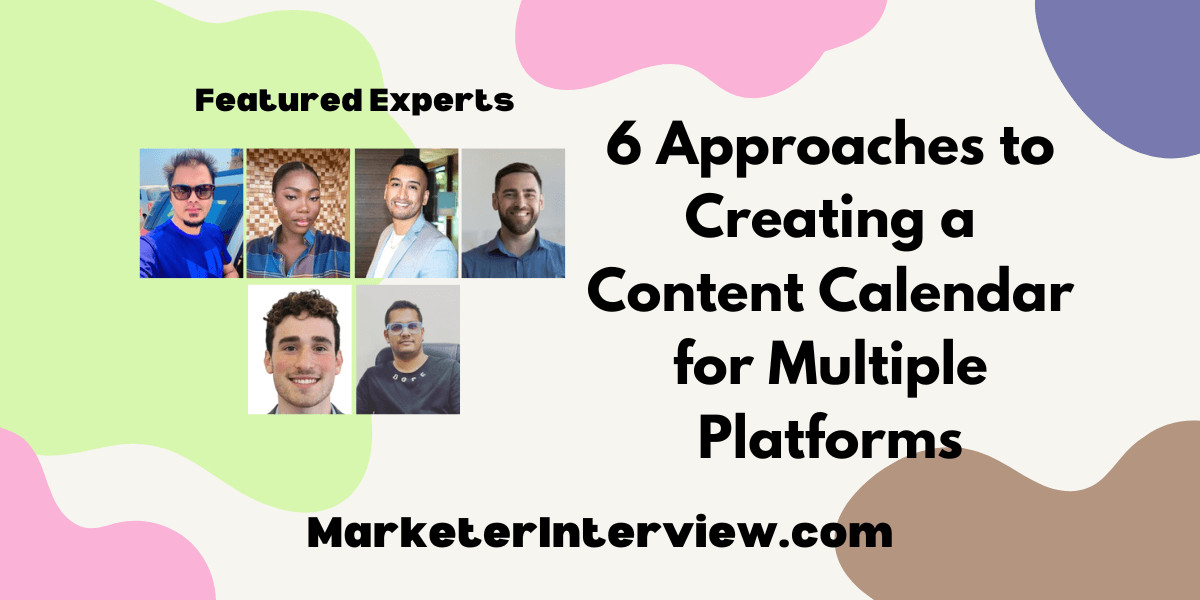6 Approaches to Creating a Content Calendar for Multiple Platforms
Diving into the art of crafting a marketing content calendar that resonates across various platforms, we’ve gathered six expert insights from top industry professionals. From applying the 80/20 content rule to aligning content with platform vibes, Growth Heads and CEOs alike weigh in on their specific strategies. Discover the full spectrum of advice on creating a marketing content calendar that truly engages your audience.
Want to get quoted in MarketerInterview.com content just like this? Apply to become a contributor today!
Contents
Apply the 80/20 Content Rule
One specific and unique approach I take when creating a marketing content calendar is to use the 80/20 rule. This means that 80% of the content I create is educational, informative, or entertaining, while 20% is promotional or sales-oriented.
I recommend this approach because it helps to build trust and loyalty with the audience, as well as increase engagement and conversions.
For example, at Content Whale, we use the 80/20 rule to create content that solves the pain points of our customers, such as how to write better content, how to optimize SEO, or how to use storytelling techniques.
We also use 20% of the content to showcase our expertise and value proposition, such as how we use AI to analyze our website analytics and provide personalized content solutions.
By using the 80/20 rule, we are able to create a balanced and effective marketing content calendar for different platforms.

Bhavik Sarkhedi, Growth Head & CMO, Content Whale
Craft Platform-Specific Thematic Stories
Drawing from my experience at CrownTV and my photography hobby, my approach centers on thematic storytelling, tailored to each platform’s unique audience and capabilities. I capture the essence of our digital signage innovations and outdoor adventures, crafting narratives that resonate. For Instagram, it’s visual storytelling; LinkedIn gets in-depth insights. This method ensures content feels native, engaging, and cohesive across platforms.
I recommend this because it leverages the strengths of each platform while maintaining a unified brand story, much like curating a gallery for different audiences.

Alex Taylor, Head of Marketing, CrownTV
Plan Out Engaging Content Themes
One specific approach I take when creating a marketing content calendar across different platforms is to plan out themes, rather than individual posts. This thematic approach helps create cohesive narratives that deeply engage my audience.
Instead of planning one-off, disconnected social media posts or blogs, I map out two- to four-week-long content runs focused on a particular topic of high interest to millennials. For example, one month I may theme content around the topic of ‘Side Hustles for Debt Payoff.’
I’ll kick things off with an in-depth, 2,000-word blog post diving into how side hustles can accelerate debt freedom. This acts as my content anchor piece.
Then I’ll break that big topic down into smaller content chunks optimized for each platform’s format and audience. For Instagram, I may create colorful Reels and carousel posts unpacking specific side hustle ideas. On Twitter, I’ll share stats and tease out key facts with short threads. In the newsletter, I can expand on tips and profile people who paid down debt with side gigs.
This allows me to go really deep on one compelling subject and tell a multi-part, 360-degree story across platforms to maximize engagement. People crave thematic, serialized narratives that build over time, rather than sporadic posts on random topics. Creating a tight content orbit keeps people plugged in, while also giving me direction each month.
The thematic approach also helps stretch a core piece of long-form content further, increasing the return on creative effort. It’s a highly strategic but efficient way to create content that resonates with millennials.

Brian Meiggs, Founder, My Millennial Guide
Know Your Target Audience
Before creating a marketing content calendar for different platforms, one specific approach I take is knowing my targeted audience. This is a very important factor to consider before crafting ideas on what content to create for different platforms. With this approach, I am able to understand my audience’s pain points, needs, interests, and preferences, which in return helps me generate content that meets their satisfaction.
I would recommend this approach to anyone who is creating a marketing content calendar for different platforms because it helps you resonate well with your audiences, helping you see their interests, needs, how well they interact with your brand, and what type of content they consume. By conducting audience research and segmentation, you can create a content calendar that addresses your audience’s problems, provides value, and builds trust.

Grace Chisom, Marketing Manager, Check CPS
Utilize Social Media Calendar Tools
I use a social-media calendar tool when creating a marketing content calendar. I use Hootsuite for this purpose, as it has a centralized dashboard for managing content across different channels simultaneously. You can also visualize your content schedule at one glance and collaborate with your team members. You can check your paid and organic social content side by side to compare their performance better.
Its calendar view allows you to view and adjust your social posts across all networks to fine-tune your campaigns whenever you want. It helps me stay organized and maintain consistency while adapting to changing priorities. A scheduling tool can improve your communication and efficiency for guaranteed success.

Faizan Khan, Public Relations and Content Marketing Specialist, Ubuy UK
Align Content with Platform Vibes
When I create a marketing content calendar for different platforms, I always start by figuring out what we want to achieve and what themes resonate best with each platform’s audience. It’s like tailoring a message to fit the vibe of a party—you wouldn’t talk about the same stuff at a casual hangout as you would at a business conference, right?
So, I make sure our content aligns with the overall marketing strategy and campaign goals, while also keeping things fresh and engaging by mixing up the types of content we share. And staying flexible is key; if something big happens or our audience responds a certain way, we’re ready to pivot and make the most of it. It’s all about finding that balance between strategy and spontaneity to keep our audience interested and connected across all our platforms.

Bennett Heyn, CEO, Sell House Columbus Ohio
Want to get quoted in MarketerInterview.com content just like this? Apply to become a contributor today!






